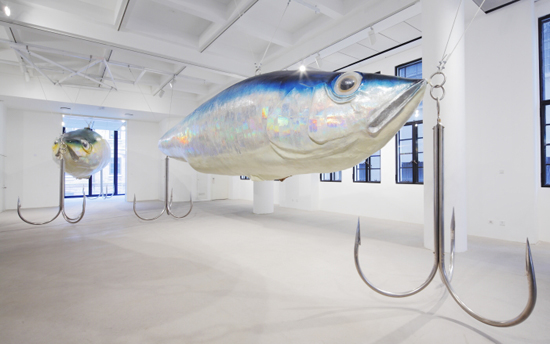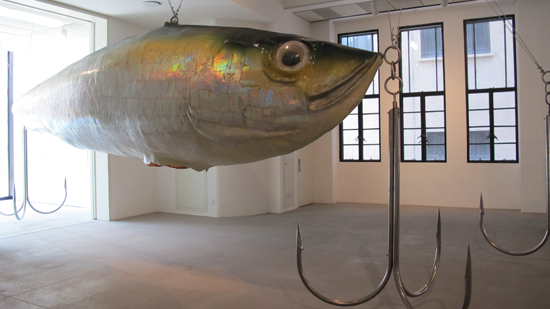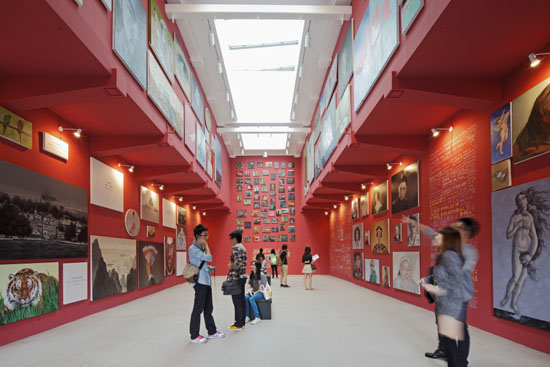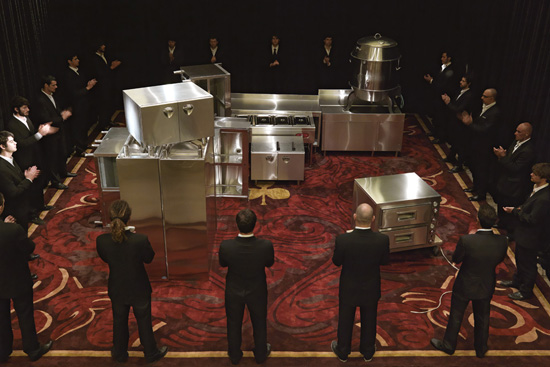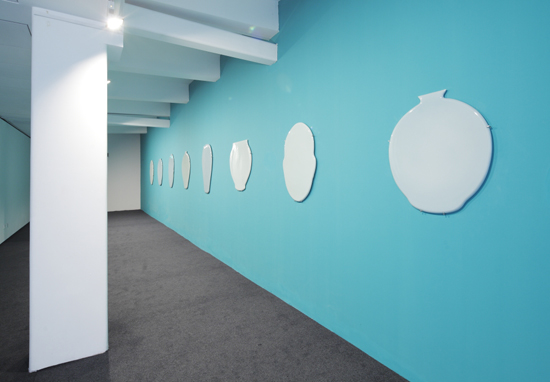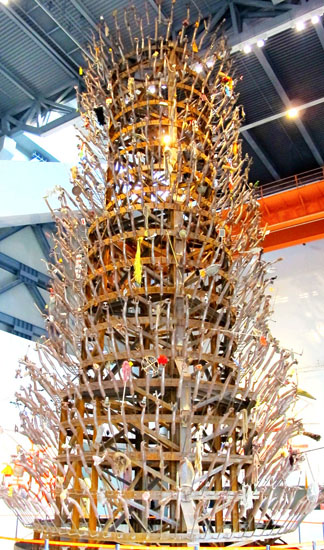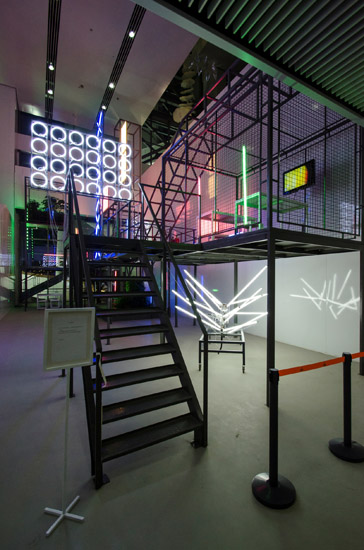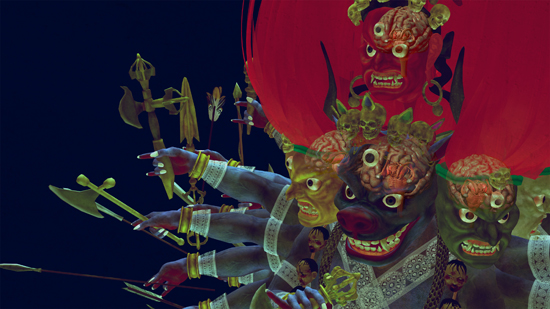Luise Guest earns her frequent flyer miles with a recent trip to ‘Reactivation’, the 9th Shanghai Biennale, and Time Traveller at the Rockbund Museum of Art…
Monstrous creatures, huge fibreglass fish, a sculpture made of spent firecrackers, and installations towering 7 stories high… Grandiose ambitions on an unprecedented scale mixed with politics and money. Toto, we’re not in Kansas any more. This must be China!
Huang Yong Ping, ‘Two Baits’, 2001, iron, fibreglass, metal sheets, 160 x 300 x 800 cm. Image reproduced courtesy of the artist and Rockbund Museum, Shanghai.
I entered Shanghai’s Rockbund Museum of Contemporary Art to see the Time Traveler exhibition in a state of some discombobulation, having spent the previous several hours walking through local streets and markets, constantly confronted with the contradictions and paradoxes of Chinese cities. Live ducks and turtles are being sold to elderly ladies wearing flowered flannelette pyjamas (a curious street fashion choice unique to Shanghai); hawkers are cooking up noodles, dumplings, intestines on sticks, yams and fish; underwear and flowered quilts are hanging everywhere to dry from power lines and on racks set up on the footpath; impromptu traders of cigarettes and mobile phone covers spruik their wares. All this in the towering glass shadow of a new shopping mall featuring Marks and Spencer, Zara and H & M. Two blocks from here is the Bund, with its Art Deco architectural reminders of a shameful time when Chinese were only permitted in certain areas of their own city.
Once inside, the legacy of Shanghai’s unique history is further underlined. The museum is housed in the former Royal Asiatic Society building, constructed in the 1930s to serve as the headquarters of the North China branch of the society, redolent of empire and European cultural institutions. It housed a vast library, natural history specimens and Chinese historical artefacts such as ceramics, bronzes and stone stelae. After falling into a decline during the 1950s, the building has been beautifully restored. But still the ghosts of history linger. Museums in the sense that we understand them (products of the wunderkammer of the European Renaissance and the urge to collect and classify of the Age of Reason) were never a part of the Asian tradition. As curator Ella Liao points out in her catalogue essay, “the museum is a kind of history made concrete; presenting a view of the world that is eternal and not open to question.” In a way museums function as time machines and its visitors are “time- travellers”.
Thus the exhibition, Time Traveler, which presents extraordinary works by avant-garde wunderkind Huang Yong Ping, Liu Jianhua, Sun Yuan & Peng Yu, and Yan Lei, is intended to evoke memories of the pre-revolutionary era of the Shanghai Museum, overlaying the natural history and cultural certainty of the 1930s with the very different identity and purpose of a contemporary art museum. The works have been chosen as much for the narratives they suggest as for their museological forms or their use of ‘natural history’ materials. As Liao says, rather than presenting us with a singular historical discourse, they employ an artificial history and geography in which the impossible becomes possible – much like the mutating and dissonant nature of the chaotic city outside its hushed quiet spaces.
Huang Yong Ping, ‘Two Baits’ 2001 (detail) photograph Luise Guest, iron, fibreglass, metal sheets, 160 x 300 x 800 cm. Image reproduced courtesy of the artist and Rockbund Museum, Shanghai.
The major drawcard of the show is the work of Huang Yong Ping, whom I believe to be one of the most extraordinary artists practising anywhere today. A big call, I know, but anyone who saw his installation at the Asia Pacific Triennial, or his enormous ‘Leviathanation’ at Tang Contemporary Art, Beijing, in which a giant fibreglass carp head, covered with the taxidermied heads of a variety of animals both large and small, is attached as the ‘engine’ of a full sized replica of the private carriage in which Mao Zedong travelled around China – plush seats with lace antimacassars, red velvet curtains and all – would have to agree that this artist’s work is like no other.
Huang has lived in Paris since 1989 where he has continued to make works which question prevailing norms and social systems, including art ‘systems’ such as the organisation of the museum and curatorial practices. In the 1980s, as a member of the radically nihilist ‘Xiamen Dada’ group, he carried out a series of actions in which works of art were damaged, burnt and reconfigured, posing some big questions about the necessity for works of art to exist in a physical form. Once in Paris, his work became concerned with the deconstruction of history, religion, myth and philosophy. Here, ‘Two Baits’ is typically monumental. Two eight-metre-long fish lures hang silently in the vast gallery space. Their bodies shine with an iridescent lustre but their eyes have the dead and filmy glaze I have just seen on all the creatures in the polystyrene crates of sea creatures in the market. Enormous, dangerously sharp hooks hang from the mouth and severed tail of each fish. Hidden in the cavity cut into the belly of one fish are books, in the other, a large knife. The work does not give up its meaning easily, but it evokes a sense of unease and of impending disaster, a sensation which lingers.
There are two stories from Chinese history about plots to usurp the throne that centre around fish. One involves a dagger hidden in the belly of a fish, the other a letter. Ji Guang, the Prince of Wu, hired an assassin to kill his cousin, the king, and had him conceal the murder weapon in the belly of a cooked fish. The other tale dates to the final years of the Qin dynasty – a letter on silk, hidden in the belly of a fish which, when caught as if by chance by common people, gave the impression that a planned uprising against the Emperor had divine support. Resistance, rebellion, massacre. Temptation and deceit. The exchange of one ruler for another, one dynasty for another, one system for another. And so it goes, on and on and on. Insert your contemporary allusion of choice.
Yan Lei, ‘Limited Art Project – Rockbund’, 2012, oil and acrylic on canvas, dimensions variable, image reproduced courtesy of the artist and Rockbund Museum, Shanghai
Yan Lei has created a space for ‘Limited Art Project – Rockbund’ which utilises rich coral coloured walls and a ‘salon hang’ of very diverse canvases, creating a ‘museum within the museum’ in a continuation of an earlier similarly titled piece shown at Documenta. The artist had over 400 paintings sent to Kassel, the works filling the entire exhibition space. During the hundred days the piece was on show, Yan Lei would take some of the paintings to a nearby Volkswagen factory to be spray-painted in a single colour. Yan would then take them back to the exhibition space and rehang them in their original position. Little by little, the paintings ‘disappeared’. The only reminder of the now obliterated painting would be a terse description of its subject written on the back — ‘Maggie Cheung with permed hair’, ‘Trees in Shenzhen’, ‘Corner Tower at the Forbidden City’, ‘Botticelli’s Venus’.
For his Rockbund installation Yan took the canvases from Kassel, now consisting of nothing more than text descriptions and dimensions, and handed them over to an anonymous group of painters, asking them to reproduce the pictures as described in the text. He made no attempt to control how they understood the text or how closely their paintings reproduced the original, thus breaking the connection between artist and object. He has said that as paintings have become a circulating commodity in the commercial arena, only commercial production processes were appropriate for their ‘manufacture’. Not unlike Jeff Koons, Yan has neatly removed himself from the process of production. In a society which produces thousands of academically trained painters from its art schools every year, and in which the concept of the ‘fake’ versus the ‘authentic’ is so problematized, this act is as radical as Joseph Kosuth’s ‘One and Three Chairs’. It was Kosuth, after all, who said, “The ‘value’ of particular artists after Duchamp can be weighed according to how much they questioned the nature of art.”
Sun Yuan and Peng Yu, ‘The World is a Fine Place for You to Fight For’, 2011, Video 89’ 20”, image reproduced courtesy of the artists and Rockbund Museum, Shanghai.
Other works in the show similarly question the nature and purpose of the museum and, in a broader sense, of art itself. Sun Yuan and Peng Yu present a video work, ‘The World is a Fine Place for You to Fight For’, which eludes any easy interpretation. A solitary lion is surrounded and attacked by wild boars; an old man sits in his study, surrounded by expressionless figures in suits and taxidermied animals – are they protecting him or imprisoning him? A red curtain swishes closed. When it re-opens, the men in black suits are still there but now they are surrounding a pile of stainless steel appliances or industrial furnishings of some kind, applauding. According to the artists, art is mere illusion. Everything is theatre. We are merely actors following a script. What is really happening here? We have no idea, and it makes us uneasy.
The other artist in the exhibition is Liu Jianhua, trained in the ceramic production centre of Jingdehzhen since the age of fifteen. Selected by the curator in a nod to the central importance of ceramics to human civilization and to the collections of major museums, she sees ceramics as a ‘’rich language in which they can speak to us.” His work in this exhibition includes a series of porcelain works simulating blank sheets of paper hanging on the wall – minimalist and deconstructionist, abandoning representation and narrative. Paradoxically, these have been said to symbolise a complete withdrawal from language. The ‘Untitled’ series consists of flat celadon ware pieces that show human faces in the outline of ancient ceramic vessels. The works represent a turning away from the outer world and a retreat to an inner world; much like the literati, for whom looking at a painting was a private act of contemplation and appreciation. Nothing could be further removed from the public function of the museum.
Liu Jianhua, ‘Untitled’ 2008, Porcelain, dimensions variable, image reproduced courtesy of the artist and Rockbund Museum, Shanghai.
And so to the Shanghai Biennale at the ‘Power Station of Art’. At his Sydney talk at the MCA in Sydney, chief curator Qiu Zhijie said “It’s bigger than Tate Modern!” And so it is. The reconstruction of the old power station, used previously for Shanghai Expo in 2010 and ready only by some miracle of typically Chinese construction practices (it was still unfinished, with painters and electricians working on the interior, a matter of days before the Biennale opened) is vast. The Biennale was for the first time further extended by a new program of ‘Inter City Pavilions’ in former shopfronts and other spaces around the city, which included the Australian Pavilion organised by Sydney’s 4A Centre for Contemporary Asian Art presenting an eclectic group of artists: Brook Andrew, Bababa International, Shaun Gladwell, Raquel Ormella, Khaled Sabsabi and Shen Shaomin who can be categorised as neither Chinese nor Australian, but rather considers himself ‘just an artist’.
Headed up by Davide Quadrio of Arthub Asia, the devolution of these city pavilions exhibiting overseas artists around Shanghai was a politically controversial move in a city where exhibitions in commercial galleries can be summarily closed down if they contravene the boundaries of what is acceptable. They had less than five months to prepare. “That is insane anywhere, but in China it can be possible,” Quadrio says. “In China, the future doesn’t exist. Even one year is too far removed.” The installation of the main exhibition in the 41,200 sq. metre powerhouse venue was not quite finished by the opening. The fact that it actually opened on schedule at all was remarkable given the staff and budget constraints. Li Xu, the deputy director of the PSA’s planning office and the curator of previous editions of the Biennale, admitted in an interview with The Art Newspaper, “Because it is a new museum and a ‘new’ biennial, these things together created a lot of trouble.” Despite all these hiccups the building, both in its scale and the design of interior spaces, is remarkable, and so is much of the work selected for the show.
It’s an impressive, albeit a somewhat confusing experience for audiences. I really, really wanted to like this. I was ready to be excited, impressed, even overwhelmed by the experience. However, unlike the recent Biennale of Sydney, which was criticised by some for the way the curatorial ‘narrative’ dominated at the expense of individual works, I found it hard to navigate and difficult to see the rationale for the inclusion and juxtaposition of particular artists and works, and the absence of others. Qiu Zhijie was assisted by co-curators Johnson Chang, Jens Hoffman, and Boris Groys, and there just isn’t enough apparent cohesion and clarity in their choices. There are also major problems with the installation and with aspects of the display of particular works.
However, there are absolute treasures to be found. The vastness of the entrance hall is dominated by the extraordinary ‘Thousand Hands Kuanyin’ (sometimes translated as ‘Bodhissativa with a Thousand Hands’) by Huang Yong Ping. An intentional homage to Marcel Duchamp’s ‘Bottle Rack’ blown up to Brobdingnagian dimensions, the work is also a nod to Tatlin’s unfinished ‘Monument to the Third International’, and a lament for the notion of a failed socialist Utopia. The thousand arms of the Goddess of Mercy protrude like mannequins in a shop window bearing unlikely objects – a tortoise, a broom, a mop, a book, a lantern. Despite being dismissed by Arts Asia Pacific as an ‘old monster’ the result is mesmerising.
Yong Ping, ‘Thousand Hands Kuanyin’, originally produced 1997, cast iron, steel and found objects, 8000x8000x18000mm, photograph Luise Guest.
In his curation of the exhibition Qiu Zhijie wanted to emphasise how artists interact with the public and their role in bringing about change. The Biennale theme of ‘Reactivation’ is appropriate in many ways. In his installation ‘Our Time’ Jiang Zhi has created a structure resembling a government palace from used firework casings in a reference to a fire started by fireworks set off by a provincial government official, which resulted in the death of a fire fighter. However, once again the impact of this work is undermined by an underwhelming display and poor lighting in a room too small for the installation. This artist’s work was seen to far greater effect in a show at Magician Space Gallery in Beijing, ‘Strait is the Gate’Shi Qing’s ‘Shanghai Electricity Mall’ was the focus of attention of the school children being herded with some reluctance around the exhibition. They momentarily abandoned their fixation on their mobile phones and clambered through the neon tubes of the play-like structure. When I interviewed this artist, who was born in Mongolia and then spent many years in Beijing before moving his studio to Shanghai, he told me that he is interested in an essential dichotomy in the Chinese identity of the artist. Is the artist a scholar or a craftsman? Shi Qing is constantly revisiting this question in his own work, and reflecting on the world of the urban megalopolis.
Shi Qing, Shanghai Electricity Mall, image reproduced courtesy of the artist and ShanghArt Gallery.
The wonderful painter Shi Zhiying is represented with a multi-panelled work, similar to her ‘Sea Sutra’ series which has been seen in Sydney at the White Rabbit Gallery. It is positioned, in what probably seemed like a good idea at the time, curving around a corner on a wall facing a glass expanse giving panoramic views of the river with its constant stream of barges and boats of all types. However this simply makes it impossible to view with the quiet concentration that her work demands, and the experience is further impeded by the orange ‘keep off’ tapes strung across the front of the floor to ceiling work. These ropes provide visual impediments to works all over the museum, an indication that there is still much to be done in order for public museums in China to lift their game.
Other notable works included Simon Fujiwara’s ‘Rebekah’, an installation of identical figures of a ponytailed girl wearing jeans and tank top, wittily recalling the Terracotta Warriors, marching down the stairs (although some of the works had fallen and were broken – by all accounts a very unfortunate installation accident) in a work aiming to consider the consequences for the individual of rapid industrialisation and mass production.
Perhaps my favourite work in the Biennale was Sophie Calle’s installation of still images and video. For ‘Last Image’ (2010) she went to Istanbul to meet blind people who had suddenly lost their sight and asked them to describe the last thing that they saw. For “Voir la Mer,” a video piece on 14 screens, the artist, together with director of photography Caroline Champetier, filmed individuals who had been blind from birth, and who were invited to “see” the ocean for the first time and describe their feelings. This is a profoundly moving work in which the artist skirts the difficult areas of tragedy and pathos, reflecting on the universality of a longing for beauty, and the significance of memory.
Lu Yang, Wrathful King Kong Core, multiscreen video projection, image reproduced courtesy of the artist and Art Labor Gallery
And the artist to watch? My vote goes to young Shanghai new media artist Lu Yang. Described by the director of the Ullens Centre for Contemporary Art in Beijing as “one of the most compelling voices in China’s new generation of multi-media artists, her work uses 3D animation, video projections, medical diagrams, supporting text and music to explore “the darker implications of modern science and technology.” ‘Wrathful King Kong Core’ (inexplicably entitled ‘The Anatomy of Rage’ in the Biennale) explores the anatomical origins of rage, melding the image of the wrathful Buddhist deity Vajrakilaya with a biological explanation of the origin and expression of anger in terms of the physiological responses of the thalamus and amygdala. Her multi-media works, animations and graphic design-influenced still images wander into dangerous and provocative territory. When I met the artist in Shanghai last year she told me she is as much interested in the boundaries of science as she is in art. Her video works owe something to music video and pop culture, something to Japanese anime culture and to contemporary design, and something to sci-fi. They are, however, most heavily influenced by the radical frontiers of scientific research. In her conversation with me she nominated Stelarc and his cybernetic artworks as the artist she most admires.
She is interested in ideas about control, specifically the way the brain controls the functions of the body and can in turn be controlled by outside agencies. This can make her work controversial, particularly the ‘Control Kraft Tremor’ series which followed a work using electrical Impulses to provoke involuntary movements in frogs with the use of Parkinson’s patients and research into treatments for the disease. The notion that her work is unethical or cruel is a misunderstanding, she says, as she merely reflects the world that we live in and the way the media reports it.
Taipei-based art writer Carol Yinghua Lu described the Shanghai Biennale as “like a monstrous figure – an ideological animal, mirroring some of the challenges and problems perturbing Chinese society today”, full of “grandiose aspirations” but still to some extent lacking the means to make them a reality. Perhaps those giant fish with their hidden messages and the Tibetan God of Wrath with his multiple avenging arms are metaphors for the Chinese artworld, and its inherent paradoxes, secrets and towering ambitions.
